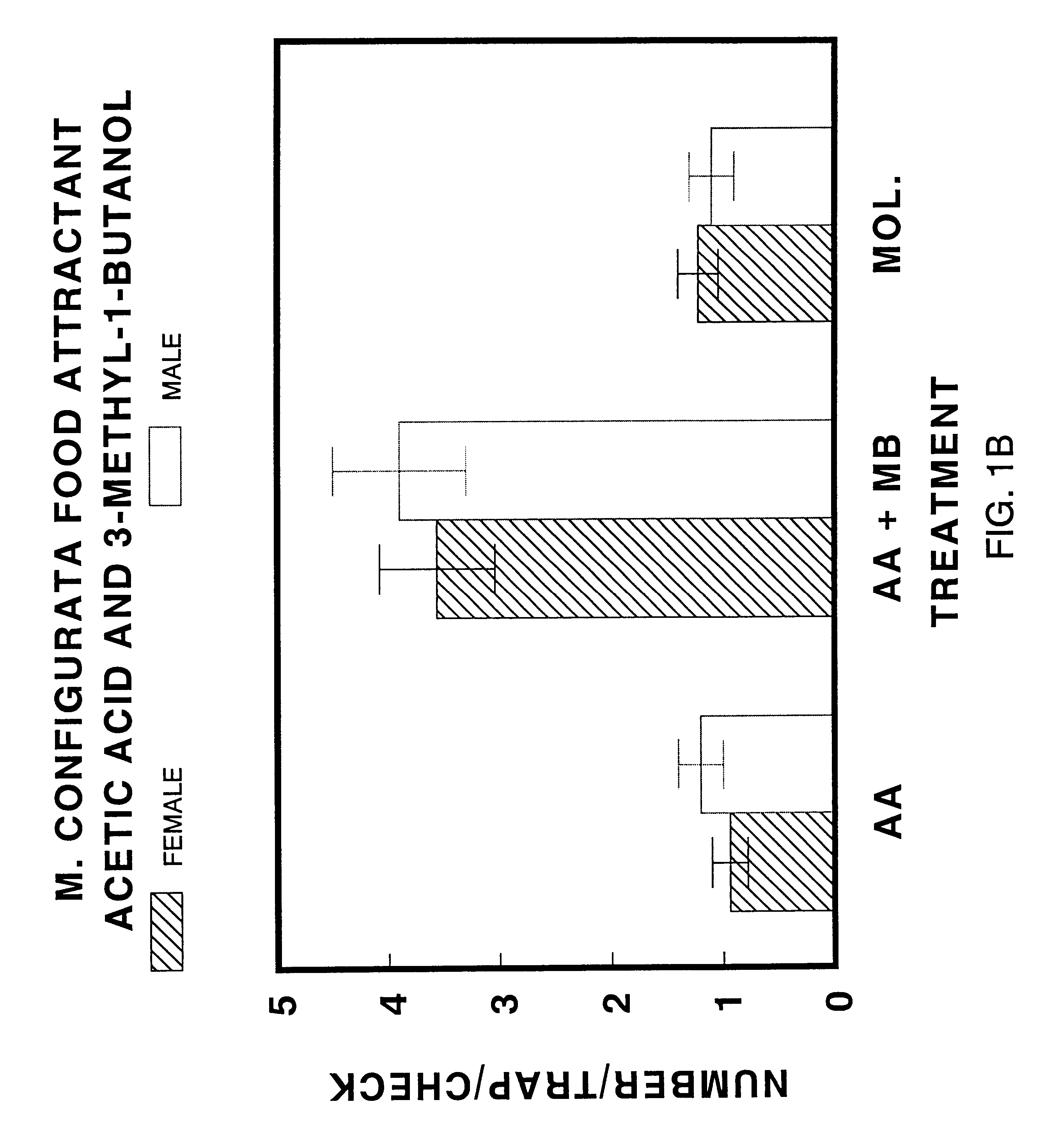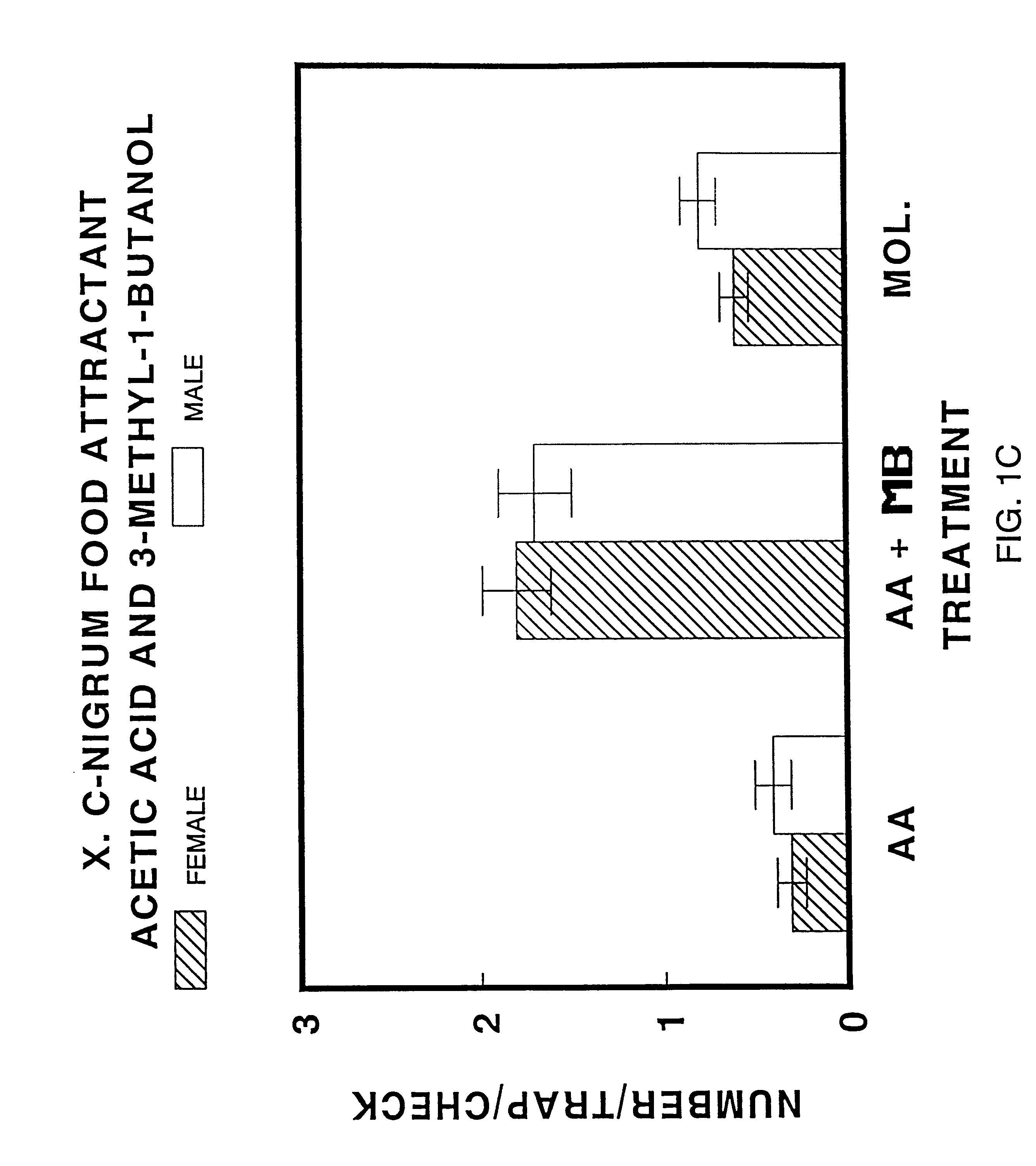Chemical attractants for moths
- Summary
- Abstract
- Description
- Claims
- Application Information
AI Technical Summary
Benefits of technology
Problems solved by technology
Method used
Image
Examples
experiment 1
Results of In the first experiment, numbers of males and numbers of females of Lacanobia subjuncta captured in traps baited with acetic acid and 3-methyl-1-butanol were significantly greater than numbers captured in traps baited with acetic acid or with molasses (ANOVA F=31.5 for females, 29.1 for males, df=387) (FIG. 1A). There was no difference between catches of male or female L. subjuncta captured in traps baited with acetic acid versus molasses. Overall, the numbers of males and females captured were similar for all treatments. Numbers of males and numbers of females of L. subjuncta captured in traps baited with acetic acid and 3-methyl-1-butanol were significantly greater than numbers captured in traps baited with acetic acid or with molasses (ANOVA F=31.5 for females, 29.1 for males, df=387) (FIG. 1A). There was no difference between catches of male or female L. subjuncta captured in traps baited with acetic acid versus molasses. Overall, the numbers of males and females cap...
experiment 2
ll baited with one ml of 3-methyl-1-butanol in a polyethylene cap and with either no acetic acid in the drowning solution or with 0.008, 0.03, 0.125, 0.5, or 2% glacial acetic acid by volume in the 200 ml of drowning solution. A randomized complete block design was used, with 4 blocks set up in late July, with each of the 6 treatments represented within each block. This experiment was maintained through August and early September.
Results of Experiment 2. Numbers of moths captured in traps were suitable for statistical analyses for L. subjuncta (LS) and bertha armyworm (M. configurata) (BAW). Spotted cutworms were not abundant in that study plot. Numbers of L. subjuncta captured in traps baited with the combination of 3-methyl-1-butanol and acetic acid increased significantly with increasing concentrations of acetic acid over the range tested (up to 2%) (FIG. 2). Numbers of moths captured in traps baited with 3-methyl-1-butanol either alone or in combination with acetic acid at a con...
experiment 3
ll baited with 0.25% acetic acid in the drowning solution and either 0, 12.5, 25, 50, or 100% 3-methyl-1-butanol in one ml of a mixture of 3-methyl-1-butanol and mineral oil. A randomized complete block design was used with each of the 5 treatments represented within each block. This experiment was set up in late July and was maintained through early September.
Results of Experiment 3. Numbers of moths captured in traps were suitable for statistical analyses for L. subjuncta (LS) and bertha armyworm (M. configurata) (BAW). Spotted cutworms were not abundant in that study plot. Numbers of L. subjuncta and numbers of bertha armyworms captured in traps baited with the combination of acetic acid and 3-methyl-1-butanol did not increase significantly with increasing doses of 3-methyl-1-butanol in caps (FIG. 3). For both species, numbers of moths captured in traps baited with acetic acid and 3-methyl-1-butanol at 12.5, 25, 50, and 100% in the cap were similar. At each dose of 3-methyl-1-but...
PUM
 Login to View More
Login to View More Abstract
Description
Claims
Application Information
 Login to View More
Login to View More - R&D
- Intellectual Property
- Life Sciences
- Materials
- Tech Scout
- Unparalleled Data Quality
- Higher Quality Content
- 60% Fewer Hallucinations
Browse by: Latest US Patents, China's latest patents, Technical Efficacy Thesaurus, Application Domain, Technology Topic, Popular Technical Reports.
© 2025 PatSnap. All rights reserved.Legal|Privacy policy|Modern Slavery Act Transparency Statement|Sitemap|About US| Contact US: help@patsnap.com



